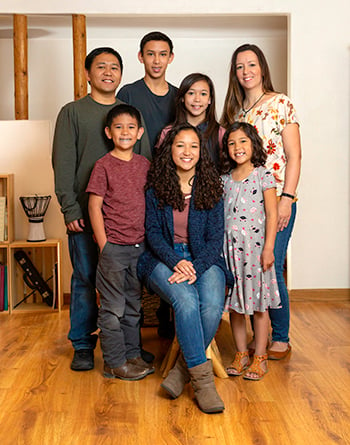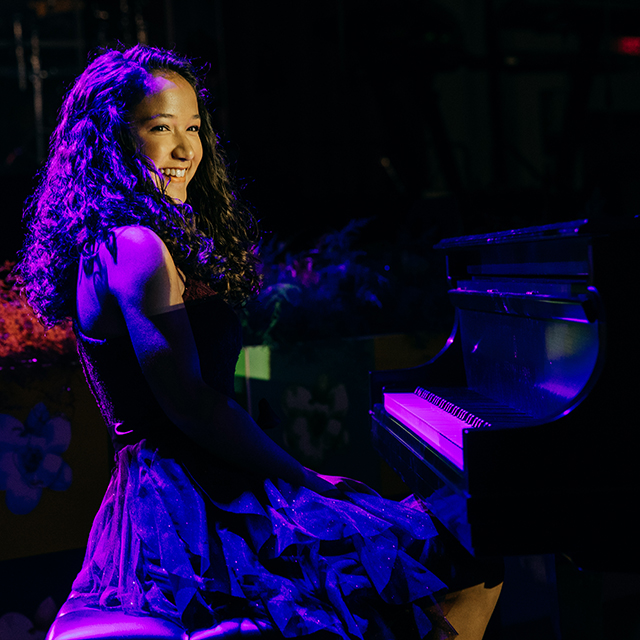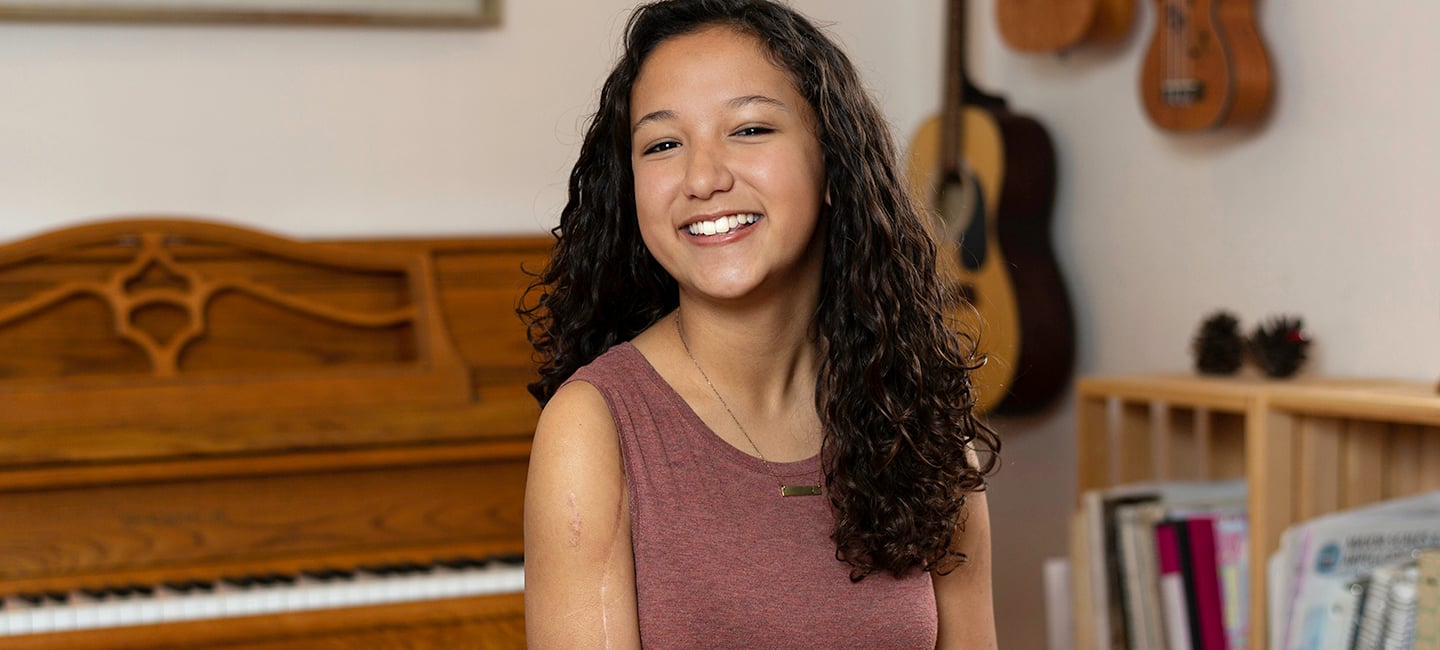Grasping the Chance with Both Hands
Parents proclaim they’d stop at nothing if their child’s life was on the line.
Would you have the strength to allow surgeons to amputate your daughter’s arm if it might save her?
Heidi and Norm Kaldenberg have faced that unthinkable decision. Their eldest child, Josalyn, was then a seemingly healthy second-grader with a passion for the piano. Heidi had played to her while she was still in the womb and began teaching her when Josalyn was just 6.
"Usually, a piano teacher will give you a certain number of songs for each week’s lesson," Heidi explains. "Josalyn would have those songs memorized in two days. She would sit for hours at the piano, any time of the day."
That all changed in October 2010, shortly before Josalyn’s eighth birthday. She’d been complaining of a sore right arm, not enough to worry her mom until a tickle battle between Josalyn and her little sister Myra. "All of the sudden, Josalyn cried out in pain. She literally went from laughter to tears because her arm got bumped. And I thought, that’s not right."
Weeks of tests and biopsies revealed that the humerus bone in Josalyn’s right arm was riddled with cancer from shoulder to elbow. Chemo started just four days before Christmas at Blank Children’s Hospital in Des Moines, Iowa. But experts around the country agreed the strong drugs wouldn’t be enough. They recommended amputation.
“When you hear the word cancer, your mind goes right to a dark place, wondering if she’ll survive,” says Heidi. “But for some reason, in my mind, it was always about the arm.
“I remember watching her at the piano and thinking, ‘God, You know she loves to play. Why would You take her arm?’”
THE GOLDEN TICKET
When it came to saving Josalyn’s arm, Heidi was not going to concede easily. “I couldn’t stand not knowing what the options might be, but nobody could tell us.
“When you hear the word cancer, your mind goes right to a dark place, wondering if she’ll survive,” says Heidi. “But for some reason, in my mind, it was always about the arm."
Norm wasn’t surprised when she resorted to Google research. “I call her the nerd of the family,” he says, “and that’s a good thing.” It led her to what they call the “golden ticket” article. Titled “Extensible endoprostheses of the humerus after resection of bone tumours,” it appeared in the May 1999 issue of The Journal of Bone and Joint Surgery. The article detailed the experience of 18 patients in Birmingham, England whose humerus bones had been replaced with an expandable device created by Stanmore Implants. Further searching linked an American surgeon working with Stanmore on such implants, Dr. Doug Letson of Moffitt Cancer Center in Tampa. An orthopedic oncologist, Letson is a renowned expert in expandable implanted devices.
"It was in print! They saved this girl’s arm with an expandable implant," says Heidi. "I thought I must be crazy because all these doctors are saying that’s not a thing. Then I looked closer and saw that the medical journal was from England. And I thought that must be why. They don’t do it here. They only do it there.”
Still, she printed it out and took it to Josalyn’s oncologist appointment, four days before surgery. They’d already signed consents for amputation, so this appointment was one last chance to discuss the plan.
“We were pretty resigned to it,” Heidi recalls. She almost forgot about the paper, showing it to the doctor at the very end of the appointment. “I said, well, this is what I thought they could do. But I guess they can’t. And he said, let me see that.”
Within minutes, their doctor came back to say he’d phoned Letson, who thought he could help Josalyn.
“And right then, everything changed,” says Heidi, “by the grace of God at the last minute.”
A SURGICAL FIRST

Josalyn's orthopedic oncology surgeon, G. Douglas Letson, MD, is involved in the design of instrumentation for minimally invasive reconstructive surgery.
A thousand miles away, Letson was finishing up another surgery when he got the call about Josalyn. The inquiry itself didn’t surprise him. “One focus of my work in orthopedic oncology has been designing implants, trying to prevent amputations in children — whether it’s an arm or a leg — to improve their quality of life,” he explains.
But the extent of Josalyn’s cancer did give him pause. “She had an unusual tumor because her entire bone had a malignancy in it,” says Letson. “Removing a whole bone and replacing it with an expandable prosthesis, those are difficult cases that we do very, very rarely.”
At that point, replacing a child’s entire humerus bone would be a first in the United States.
But once he saw Josalyn’s scans, Letson says, he had no doubt they’d be able to remove the tumor and reconstruct her arm. “I couldn’t wait to be able to help her out,” Letson recalls.
Josalyn couldn’t wait very long, either.
With the cancer still in her arm, she would begin another round of chemo aimed at limiting its growth while Letson prepared for this surgical first. Since Moffitt does not provide care for pediatric patients, that would mean enlisting the help of a hospital capable of handling orthopedic surgeries in children. Letson approached Shriners Hospitals for Children in Tampa, where he performed pediatric operations. “Once they understood the need, they opened their doors and said we will absolutely let you use our facilities without any cost, anything that we can do to help.”
Then there was the matter of what would replace Josalyn’s cancer-riddled bone. Letson had long consulted with Stanmore Implants in Great Britain on the design of custom, expandable devices to replace bones in children. “We’d been working on developing these prostheses that we could lengthen as the child grows,” explains Letson.
“We’d been working on developing these prostheses that we could lengthen as the child grows."
In Josalyn’s case, this would entail annual follow-up outpatient surgeries performed through an incision the size of a pencil eraser. A special screwdriver would be inserted into the device to turn gears in the telescoping prosthesis, increasing its length a few millimeters at a time. Josalyn would need these lengthening procedures until she was fully grown. Letson and the engineers at Stanmore worked from Josalyn’s scans to design the implant, which the company provided at reduced cost. With countless updates and coordination over the phone and email, the process would take six weeks.
And then, patient, family and surgeon would finally meet.
WORRYING ABOUT WHAT-IFS
For Josalyn, the trip to Tampa would be a first airplane flight and a trip to the beach. The surgery part wasn’t tops on the 8-year old’s list. “I didn’t care if it was going to help me, I just didn’t want to have surgery, period,” she recalls with a laugh.

“Cancer doesn’t just happen to one person," says Josalyn's mom Heidi. "It happens to the whole family." Pictured, left to right, top row: dad Norm, siblings Isaiah and Myra, mom Heidi. Front row, brother Wesley, Josalyn and sister Layna.
She had already been through so much in just the previous year. Ten months before she was diagnosed, cancer had claimed her Uncle Nathan. “I remember when my mom told me I had cancer, the first thing that went through my mind was I’m going to die, too,” Josalyn remembers. Small wonder, then, that Josalyn’s parents never mentioned the word “amputation” to their daughter. “Being innocent is good, because then you don’t think about all the ‘what-ifs,’” she says.
Josalyn left those worries to her parents and her surgeon, who met face-to-face the very first time on the day before her surgery. “It was straight to hugs,” recalls Heidi. “Looking back, that was a lot of trust. But at the time, we were just so hopeful about the situation that we felt it was going to work out.”
Among the surgical risks they discussed, Letson had to remind them that amputation was still a possibility. If the tumor had spread beyond the bone to encase any of the blood vessels or nerves necessary to maintain function of the arm, he couldn’t risk leaving any cancerous tissue behind.
On April 26, 2011, Letson and his surgical team began the tedious process of freeing muscle, nerve and blood vessels from the bone in Josalyn’s arm. All would have to be examined for any trace of tumor and preserved in place for reconstruction of the arm. The entire bone would need to be removed in a single piece, leaving no trace of tumor behind. Then, rebuilding Josalyn’s arm could begin. Artificial shoulder and elbow joints would hold the expandable prosthesis in position, and a vascular sleeve on the device would provide a place for muscles to be reattached and eventually grow to enable it to function.
“Being innocent is good, because then you don’t think about all the ‘what-ifs.'"
Eight hours later, Josalyn and her parents were reunited in the recovery room. The operation, Letson told them, couldn’t have gone any better. “But once my part was done,” says Letson, “she had a lot of hard work left to do.”
HALF A LIFETIME AGO
Fast forward eight years and a different thousand miles to Carlsbad, New Mexico. A teen with long, brown curls tends to a handful of goats and more than a dozen chickens outside the family home, while two large dogs keep a watchful eye.
This is Josalyn’s happy place, among her precious animals. Cuddling one goat in her lap, she reaches out to smooth another’s coat. “I just love my animals,” she says. “They always cheer me up just like the therapy dogs did when I was in the hospital.”
In some ways, those post-surgery months of continued chemo and grueling physical therapy seem to her like a lifetime ago. After all, the eight years she’s lived with her new “bionic” arm are half of Josalyn’s lifetime.
But in other ways, the memories remain close. “Whatever I’m doing, I do it with all of my heart,” she says. “Something as simple as holding Theodore the goat, working on my sketches or playing the piano is very precious to me — so much more so with both arms.”
Now 16, Josalyn is back to being the “leader of the pack” of her four younger siblings. “She’s the one who comes up with the ideas for games and projects,” Heidi says. “Cancer doesn’t just happen to one person, it happens to the whole family. And when you have a lot of little ones whose big sister is sick, that’s a journey for everyone.” Thankfully, with eight cancer-free years behind her, that journey is in the rearview mirror.
In those years, Josalyn has also nurtured her artistic talents. She’s returned to playing piano, practicing daily on the one in her family’s living room. Her drawings, especially of animals, are remarkably lifelike. She’s shared special animal portraits along the way, including one of a beloved German shepherd owned by Tampa restaurateur and Moffitt Foundation Board member Richard Gonzmart. He became a family friend through the Kaldenbergs’ return trips to Tampa as Josalyn’s "bionic" arm was regularly lengthened. “He really took Josalyn under his wing,” says Heidi. Josalyn still has the medals he sent her from his participation in various running events to encourage her to keep going in treatment and therapy. “He’s been a blessing to our family,” adds Heidi. “It’s so nice to have friends when we go back to Tampa.”
MUSICAL THANKS
On one of those return trips for an outpatient lengthening procedure, Josalyn decided to offer thanks to her surgeon by playing the piano in Moffitt’s lobby. “I spent months preparing that song,” says Josalyn. “I was so excited!
“I just really wanted to show Dr. Letson that this is what you allowed me to do by saving my arm.”
Letson admits it was hard to keep back the tears as he watched her play. “It was a huge effort for her to rebuild that arm and she was able to do it,” says Letson. “And I’m just so proud of her.”
“I don’t think there are enough words to thank Dr. Letson,” says Norm. “I’d rather give him a hug.”
To Heidi, Letson personifies Moffitt. “It’s not just a matter of saving lives, but what are these lives going to be like? For us, Moffitt means we have music in our house on any given day of the week. It means that the world has the gift of Josalyn’s art and her music and all the other things that she can do with that arm. And it means that a lot of other kids in the United States will get that chance, too, because of Dr. Letson’s work.”
“Every day, something similar like this is happening at Moffitt,” Letson says humbly. “Whenever there is a patient need, our faculty always go over and above, whatever it takes to help that patient out.”

Josalyn playing piano at the 2019 Magnolia Ball.
A video testimonial of Josalyn’s story was shown at the 2019 Magnolia Ball, where Josalyn surprised guests with an in-person piano performance. Watch it here.


